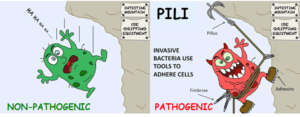
How bacteria get (too) attached
Pathogenic bacteria developed different mechanisms to attach to human host cells. However, our immune system learned to fight back, so that a constant battle between bacteria and host is happening in our bodies.
Sarah Wettstadt is a microbiologist-turned science writer and communicator writing for professional associations, life science organisations and researchers from the biological sciences. She runs the blog BacterialWorld and co-published the colouring book “Coloured Bacteria from A to Z”. As science communication manager for the Scientific Panel on Responsible Plant Nutrition and blog post commissioner for the FEMSmicroBlog, Sarah writes about microbiology and environmental topics for various audiences. To help scientists improve their science communication skills, she co-founded SciComm Society, through which she offers guides, webinars and 1-on-1 coaching. Previous to her science communication career, Sarah did a PhD at Imperial College London, UK, and a postdoc at the CSIC in Granada, Spain. In her non-scicomm time, she enjoys the sunny beaches in Spain playing beach volleyball or travels the world.

Pathogenic bacteria developed different mechanisms to attach to human host cells. However, our immune system learned to fight back, so that a constant battle between bacteria and host is happening in our bodies.
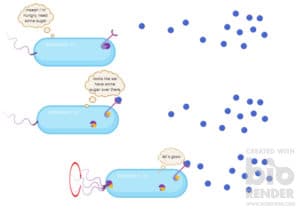
Chemotaxis helps bacteria to know that they are surrounded by certain chemicals. They can then move towards them if the chemicals are helpful. But how does chemotaxis work? Find out here.

Bacteria developed different antimicrobial resistance mechanisms to get rid of antibiotics. Here, you will learn what bacteria do with antibiotics so that they don’t harm them and what superbugs are.
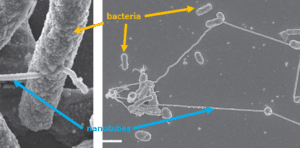
When bacteria are hungry, they sometimes also need the help of their friends. In that case, bacteria can build little tubes between them to exchange nutrients. With this bacterial nanotube, they can exchange nutrients and thus feed each other to make sure everyone survives.
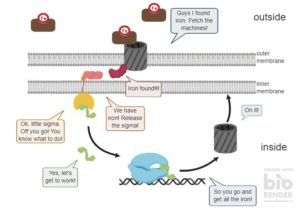
Bacteria sense iron in the environment via proteins that are transporters and receptors in one. The transporter imports iron, while the receptor tells the bacterium that iron is present on the outside. This activates a whole circuit so that the bacterium produces more transporters to capture as much iron as possible.
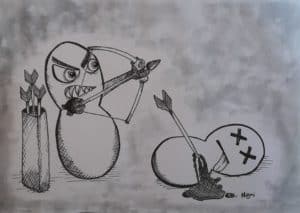
Bacterial killing is happening everywhere where bacteria fight for space and nutrients. Some bacteria have highly efficient weapons to kill other microbes. These killer bacteria can survive in the rarest and driest environmental niches. Just by killing other bacteria.
What kind of fantastic nanoweapon is that?
Sarah Wettstadt is a microbiologist-turned science writer and communicator writing for professional associations, life science organisations and researchers from the biological sciences. She runs the blog BacterialWorld and co-published the colouring book “Coloured Bacteria from A to Z”. As science communication manager for the Scientific Panel on Responsible Plant Nutrition and blog post commissioner for the FEMSmicroBlog, Sarah writes about microbiology and environmental topics for various audiences. To help scientists improve their science communication skills, she co-founded SciComm Society, through which she offers guides, webinars and 1-on-1 coaching. Previous to her science communication career, Sarah did a PhD at Imperial College London, UK, and a postdoc at the CSIC in Granada, Spain. In her non-scicomm time, she enjoys the sunny beaches in Spain playing beach volleyball or travels the world.